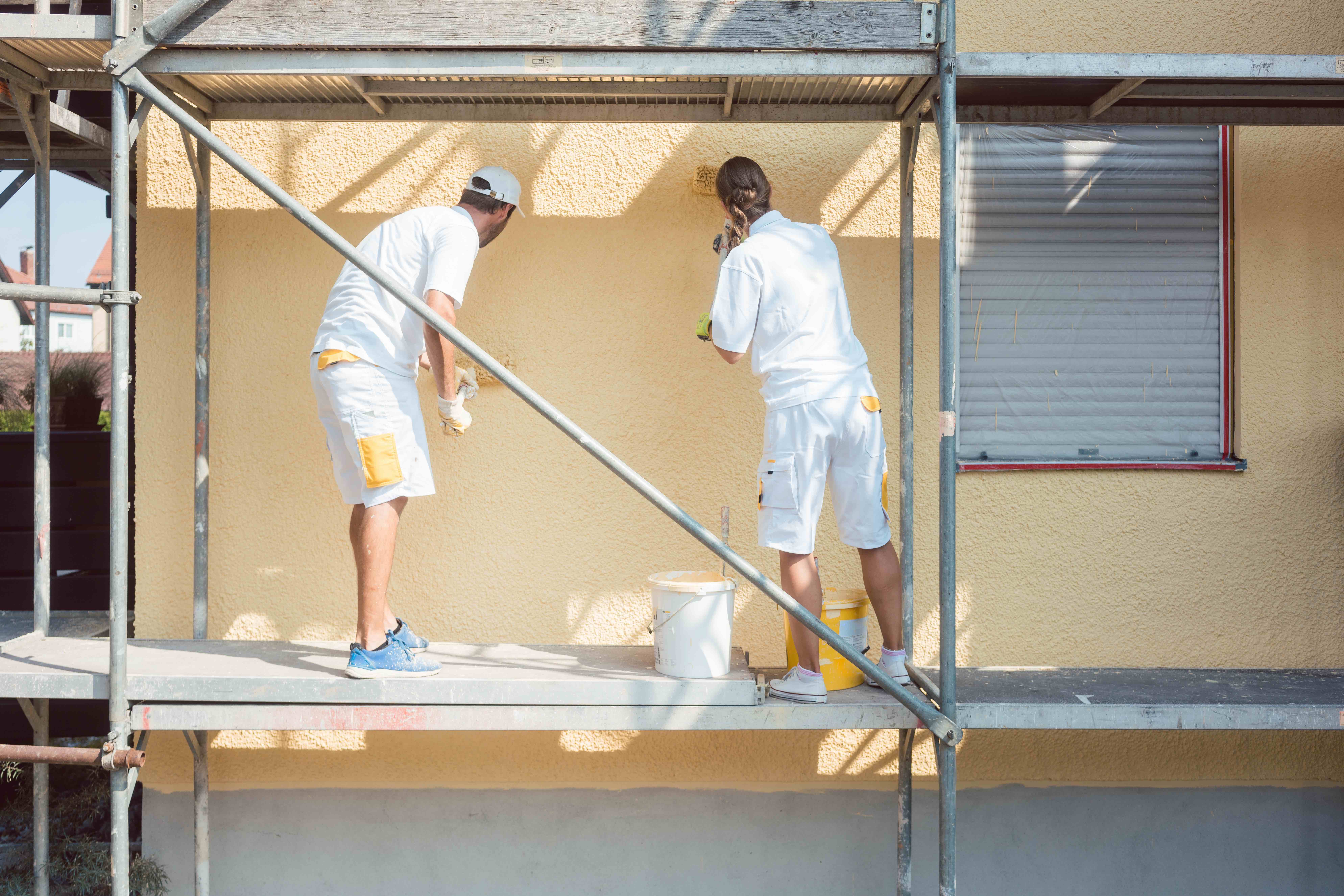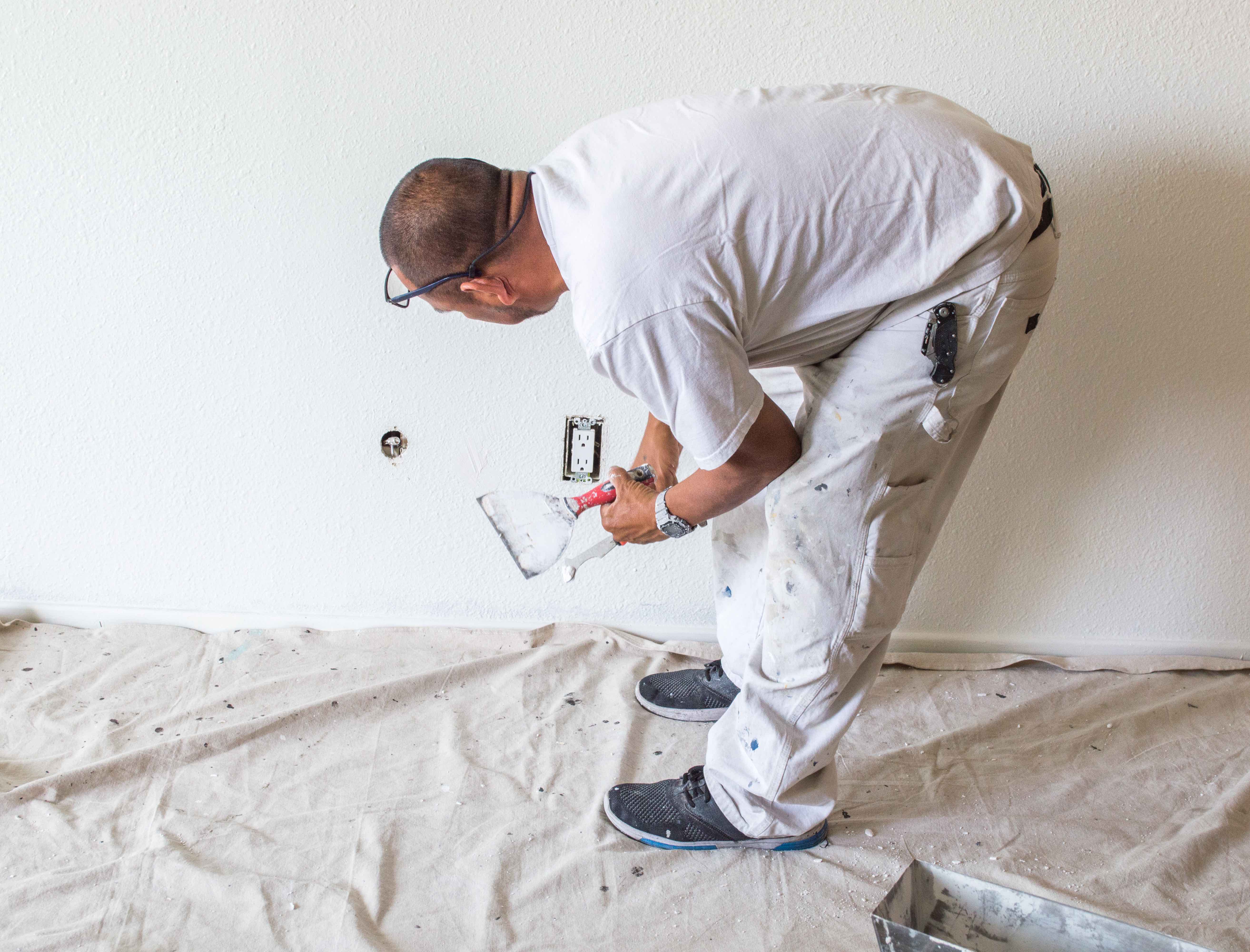
White is normally associated with purity. This is why we see brides wearing white gowns because it conveys the sanctity of marriage. White also has positive meanings including cleanliness and safety. This is why hospitals, kitchens, and other rooms in your house you want cozy are painted white. Painters are usually seen sporting a white shirt, pants, or just a white overall outfit when they are at work. If you clicked here because you’re puzzled why painters wear white, below are reasons that will give you answers.
White is the base color of the materials they use.
White is often used as the first layer of paint or primer but it’s not the only material they use that comes in white. Caulk and patching compounds including spackle and plaster are primarily white and wearing white conceals splotches from these materials.

Painters used to mix the white lead powder with paint paste to make a paint and the process produces white dust all over the place. They can conceal these dust particles by wearing white. White is the base color in creating the color that you want. It is safe to say that white is everywhere if you are a painter.
Almost all the time, these materials find their way into the painter’s clothes and they eliminate this problem by simply wearing white.
White clothes are affordable.
White clothes are cheaper than all of their colored counterparts because it is much easier for manufacturers to produce clothes with the base color of the raw materials. Furthermore, white clothing is also commonly available in bulk orders or bundled in stores, allowing consumers to save more. We can say that white clothing is a wise budgetary choice.
Besides, white goes well with almost anything, whether it’s your shoes, socks, or other accessories. The white tone balances the overall attire and blends well regardless of the color of clothing and accessories that you put it with.
A little mess on clothing in work like painting is inevitable, it’s just the easiest choice to buy affordable white clothes.
It is easier to bleach the white overalls if you splotched them with paint.
Bleach removes paint stains and essentially restores the color of white clothing better than any other color of clothes. Bleaching is also an effective disinfectant than the mainstream disinfectant. Just remember to use it moderately to avoid damaging the fabric, or worse, causing tears.
White-colored clothes keep your body cool.
White is the coolest color because it reflects light and absorbs less heat better than any other color. White is the reflection of all visible light hitting on the surface of an object. Black is the opposite because it absorbs all light on the visual spectrum and creates a void of light. Shiny colors reflect more light than flat colors but the color is still the primary factor of heat absorption.
Many homes are painted in white because it keeps the house cooler. This is the same reason why people wear white – to ease the warm weather, and painters are no exception. Wearing white helps them to comfortably work under the sun when they need to.

White uniform is an awareness of wet paint.
White easily attracts attention from a distance, which helps warn people if a certain place is freshly painted. This simple reason helps keep people from leaning or leaving imprints on the walls and avoid having to redo the painting.
What does white symbolize?
White is associated with purity, cleanliness, safety, or simplicity. This is especially true when talking about religious ceremonies. The Roman brides started wearing white to a wedding more than 2,000 years ago because it mirrors a woman’s virginity.
The color of a restaurant, a hospital, and the uniform of the medical professionals are white or in the same hue to represent cleanliness and safety. This impression also applies to painters who wear white that they will do a neat job and take care of your house just as they would do with their own. Colors create emotions, thus the professionality of looking clean in their white uniform gives confidence to their clients or employers.
Origin of the painter’s pants
The painter’s pants, aside from being white, are characterized by their heavily stitched seams and loose pockets to hold most painting tools including brushes, putty knives, screwdrivers, and rags.

White pants were once made from discarded sails of ships that are generally white canvas. Painters found it very durable and lightweight, suited as workwear for its added comfortability and practicality. It is believed to have started the tradition of wearing white painter’s pants. Although the white pants that we know were originally designed for painters, the manufacturers of work clothes such as Dickies started producing painter’s pants for the general public in the 1920s.
In the 1970s, the Women’s and Gay Liberation Movement led by young people wore painter’s pants as part of their protest against worker clothes only being reserved for men. Soon enough, in the late 1970s, painter’s pants became fashionable and started being worn by many. Just like how blue jeans have become a fashion item by those who don’t wear them for work, white pants became popular among different walks of life. People splattered the white pants with paint and some wore them with a hammer loop or colorful bandanna and a painter’s hat.
What protective gears do painters wear?
Shirts and pants
They might seem trivial but they provide protection from the many possible splashes of paint. Wearing a pair of pants and shirt, preferably with sleeves keeps you from being directly in contact with possibly harmful contents of paint and saves you time in scrubbing paint smears off your skin.
Safety goggles
Painting in the ceiling does not only cause neck pain, but may also cause droplets on the face or the eyes. The safety goggles come in handy to make sure your vision isn’t compromised.
Work boots
This is one must-have piece of equipment when working on a construction site. They give comfort for long hours of standing andoffer safety features by avoiding puncture and providing grip, especially if you are standing on stairs and on smooth surfaces.
Respirator
Avoid harmful chemicals present in the paint from entering your airways by wearing respirators. These are useful against paint vapors that are produced when using airbrushes.
Headgear
This works best with safety goggles to protect your head from falling debris while working on high walls and ceilings.
Apron
Wearing an apron is optional if you want extra protection for your clothes.
How to remove water-based paint from white clothes?
- Soak the cloth in warm water to scrape the water-based paint. Heat softens the paint and helps in detaching paint from the fabric.
- Scrub using a soft brush with detergent soap. Wash the clothe like you would normal laundry and gently scrub the part with the stain.
- Use bleach if the stain doesn’t fade. Just remember to use the right amount to avoid damaging the fabric.
- Repeat the process until the paint stain disappears.
White is simply a painter’s uniform.
The painter’s white uniform is a tradition of the painting profession. Painters have been officially wearing white since 1887 when The Brotherhood of Painters and Decorators of America was founded to build a community of painters. The union changed its name to the International Brotherhood of Painters and Allied Trades in January 1970.
In 2000, they settled on the name International Union of Painters and Allied Trades (IUPAT). Painters were already known to wear white before the union was founded so they have continued to wear white as a uniform to distinguish themselves from non-union employees. Painters nowadays are wearing white whether they are members or not.

As we discussed, one of the practical reasons for wearing white is that the majority of the materials that the painters use are white. Back in the day, white is the only color that is painted on houses or buildings and the preparation materials are also white such as spackle, plaster, and caulk. White clothes hide the splotches and drips of these materials. It also makes sense to wear a white uniform as it blends well with any color, which in return saves time when choosing clothes for a day of work.
The branding of a company is also more visible in white clothes. This becomes an ideal way to market services and get more jobs. Wearing white overalls for work is not only to identify oneself from other workers on a construction site but also a part of the glory and pride of the profession.
Wearing white has become the recognized uniform in the industry – a white shirt or white long sleeve shirt, and a pair of white pants make up the “painter’s whites” as we know them today.
Was this page helpful?
Our commitment to delivering trustworthy and engaging content is at the heart of what we do. Each fact on our site is contributed by real users like you, bringing a wealth of diverse insights and information. To ensure the highest standards of accuracy and reliability, our dedicated editors meticulously review each submission. This process guarantees that the facts we share are not only fascinating but also credible. Trust in our commitment to quality and authenticity as you explore and learn with us.


